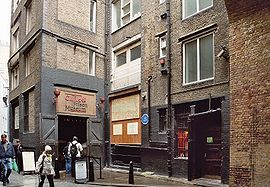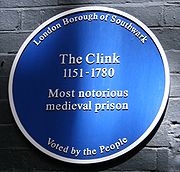
Liberty of the Clink
Encyclopedia


Southwark
Southwark is a district of south London, England, and the administrative headquarters of the London Borough of Southwark. Situated east of Charing Cross, it forms one of the oldest parts of London and fronts the River Thames to the north...
, on the south bank of the River Thames
River Thames
The River Thames flows through southern England. It is the longest river entirely in England and the second longest in the United Kingdom. While it is best known because its lower reaches flow through central London, the river flows alongside several other towns and cities, including Oxford,...
, opposite the City of London
City of London
The City of London is a small area within Greater London, England. It is the historic core of London around which the modern conurbation grew and has held city status since time immemorial. The City’s boundaries have remained almost unchanged since the Middle Ages, and it is now only a tiny part of...
. Although situated in Surrey
Surrey
Surrey is a county in the South East of England and is one of the Home Counties. The county borders Greater London, Kent, East Sussex, West Sussex, Hampshire and Berkshire. The historic county town is Guildford. Surrey County Council sits at Kingston upon Thames, although this has been part of...
the liberty
Liberty (division)
Originating in the Middle Ages, a liberty was traditionally defined as an area in which regalian rights were revoked and where land was held by a mesne lord...
was exempt from the jurisdiction of the county's high sheriff
High Sheriff of Surrey
-List of High Sheriffs of Surrey:The list of known High Sheriffs of Surrey extends back to 1066 At various times the High Sheriff of Surrey was also High Sheriff of Sussex -1066-1228:...
and was under the jurisdiction of the Bishop of Winchester
Bishop of Winchester
The Bishop of Winchester is the head of the Church of England diocese of Winchester, with his cathedra at Winchester Cathedral in Hampshire.The bishop is one of five Church of England bishops to be among the Lords Spiritual regardless of their length of service. His diocese is one of the oldest and...
who was usually either the Chancellor or Treasurer of the King.
The liberty was originally north-eastern part of the 'hide of Southwark' granted by Henry I to the Priory of Bermondsey (later Bermondsey Abbey
Bermondsey Abbey
Bermondsey Abbey was an English Benedictine monastery. Most widely known as an 11th-century foundation, it had a precursor mentioned in the early 8th century, and was centred on what is now Bermondsey Square, the site of Bermondsey Market, Bermondsey in the London Borough of Southwark, southeast...
) in 1104-09 and that house then sold it to the Bishop of Winchester in ca 1149, who wanted a house for his London governmental duties. The Bishopric's administration referred to it as the 'Manor of Southwark' ie the Manor of the Bishop in Southwark. It was also known as the 'Liberty of Winchester'. The liberty (ie a manorial jurisdiction) was confirmed when King Stephen
Stephen of England
Stephen , often referred to as Stephen of Blois , was a grandson of William the Conqueror. He was King of England from 1135 to his death, and also the Count of Boulogne by right of his wife. Stephen's reign was marked by the Anarchy, a civil war with his cousin and rival, the Empress Matilda...
sanctioned the transaction for his brother Henry Blois, then Bishop of Winchester. It was approximately 70 acres (28 hectares) in size and was situated in the modern Bankside
Bankside
Bankside is a district of London, England, and part of the London Borough of Southwark. Bankside is located on the southern bank of the River Thames, east of Charing Cross, running from a little west of Blackfriars Bridge to just a short distance before London Bridge at St Mary Overie Dock to...
area of the London Borough of Southwark
London Borough of Southwark
The London Borough of Southwark is a London borough in south east London, England. It is directly south of the River Thames and the City of London, and forms part of Inner London.-History:...
. Clink Street and Winchester Street recall the former liberty.
It formed part of the parish of St Margaret's, Southwark until 1539 when it was closed being replaced by St Saviour's (now Southwark Cathedral
Southwark Cathedral
Southwark Cathedral or The Cathedral and Collegiate Church of St Saviour and St Mary Overie, Southwark, London, lies on the south bank of the River Thames close to London Bridge....
). As a civic area it was united in the St Saviour's District
St Saviour's District (Metropolis)
St Saviour's was a local government district within the metropolitan area of London, England from 1855 to 1900. It was formed by the Metropolis Management Act 1855 and was governed by the St Saviour's District Board of Works, which consisted of elected vestrymen.Until 1889 the district was in the...
with St Saviour's and Christchurch, Surrey under the Metropolitan Board of Works
Metropolitan Board of Works
The Metropolitan Board of Works was the principal instrument of London-wide government from 1855 until the establishment of the London County Council in 1889. Its principal responsibility was to provide infrastructure to cope with London's rapid growth, which it successfully accomplished. The MBW...
from 1855.
The Clink is most famous for its prison
The Clink
The Clink was a notorious prison in Southwark, England which functioned from the 12th century until 1780 either deriving its name from, or bestowing it on, the local manor, the Clink Liberty . The manor and prison were owned by the Bishop of Winchester and situated next to his residence at...
. The first recorded use of the term Liberty of the Clink was in 1530; the nickname was used informally to avoid confusion with the other manors in Southwark. 'Clink' seems to be derived from the name of the Bishop's prison, which he held as a civil authority deriving from his role as Chancellor or Treasurer. It was also the manorial gaol maintained by the bishop as part of the administration of the liberty.
The bishop's London residence, Winchester House
Winchester Palace
Winchester Palace was a twelfth century palace, London residence of the Bishops of Winchester. It is located south of the River Thames in Southwark, near the medieval priory which today has become Southwark Cathedral.-History:...
was built in the liberty, originally surrounded by parkland.
Illicit activities
The liberty lay outside the jurisdiction of the City of London, and that of the county authorities of Surrey, and activities forbidden in those areas were permitted within it.Prostitution
In 1161 the bishop was granted the power to licence prostitutes and brothels in the liberty. The prostitutes were known as Winchester Geese, and many are buried in Cross BonesCross Bones
Cross Bones is a post-medieval disused burial ground in The Borough, Southwark, south London, in what is now known as Redcross Way.It is believed to have been established originally as an unconsecrated graveyard for "single women," a euphemism for prostitutes, known locally as "Winchester Geese,"...
, an unconsecrated graveyard. Similarly, to "be bitten by a Winchester goose" meant "to contract a venereal disease", and "goose bumps
Goose bumps
Goose bumps, also called goose flesh, goose pimples, chill bumps, chicken skin, funky spots, Dasler Bumps, chicken bumps or the medical term cutis anserina, are the bumps on a person's skin at the base of body hairs which may involuntarily develop when a person is cold or experiences strong...
" was slang for symptoms of venereal diseases.
Theatres
Theatres and playhouses were allowed in the Clink, the most famous being the Globe TheatreGlobe Theatre
The Globe Theatre was a theatre in London associated with William Shakespeare. It was built in 1599 by Shakespeare's playing company, the Lord Chamberlain's Men, and was destroyed by fire on 29 June 1613...
where William Shakespeare
William Shakespeare
William Shakespeare was an English poet and playwright, widely regarded as the greatest writer in the English language and the world's pre-eminent dramatist. He is often called England's national poet and the "Bard of Avon"...
performed his plays. Another noted one was The Rose
The Rose (theatre)
The Rose was an Elizabethan theatre. It was the fourth of the public theatres to be built, after The Theatre , the Curtain , and the theatre at Newington Butts The Rose was an Elizabethan theatre. It was the fourth of the public theatres to be built, after The Theatre (1576), the Curtain (1577),...
, where Shakespeare and Christopher Marlowe
Christopher Marlowe
Christopher Marlowe was an English dramatist, poet and translator of the Elizabethan era. As the foremost Elizabethan tragedian, next to William Shakespeare, he is known for his blank verse, his overreaching protagonists, and his mysterious death.A warrant was issued for Marlowe's arrest on 18 May...
both premiered plays.
Abolition
During the period of the CommonwealthCommonwealth of England
The Commonwealth of England was the republic which ruled first England, and then Ireland and Scotland from 1649 to 1660. Between 1653–1659 it was known as the Commonwealth of England, Scotland and Ireland...
the episcopy was abolished, and the liberty was sold to a private owner in 1649. It was returned to the bishop on the restoration in 1660.
The Clink prison was destroyed in 1780, and the bishop's palace in 1814. In 1856 most local government in the area passed to the St Saviour's District Board of Works and the Metropolitan Board of Works
Metropolitan Board of Works
The Metropolitan Board of Works was the principal instrument of London-wide government from 1855 until the establishment of the London County Council in 1889. Its principal responsibility was to provide infrastructure to cope with London's rapid growth, which it successfully accomplished. The MBW...
. In 1863 the rights of the Bishop of Winchester in the liberty were vested in the Ecclesiastical Commissioners
Ecclesiastical Commissioners
Ecclesiastical Commissioners were, in England and Wales, a body corporate, whose full title is Ecclesiastical and Church Estates Commissioners for England. The commissioners were authorized to determine the distribution of revenues of the Church of England, and they made extensive changes in how...
.
The liberty was finally abolished in 1889, when the Local Government Act 1888
Local Government Act 1888
The Local Government Act 1888 was an Act of the Parliament of the United Kingdom, which established county councils and county borough councils in England and Wales...
merged all remaining liberties into counties
Administrative county
An administrative county was an administrative division in England and Wales and Ireland used for the purposes of local government. They are now abolished, although in Northern Ireland their former areas are used as the basis for lieutenancy....
. The Liberty of the Clink thus became part of the new County of London
County of London
The County of London was a county of England from 1889 to 1965, corresponding to the area known today as Inner London. It was created as part of the general introduction of elected county government in England, by way of the Local Government Act 1888. The Act created an administrative County of...
.
External links
- The borough of Southwark manors, from the Victoria County History of Surrey

